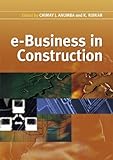| Title: | E-business in Construction |
| Categories: | Construction |
| Authors: | Chimay J. Anumba, Kirti Ruikar |
| ISBN-10(13): | 1405182342 |
| Publisher: | Wiley-Blackwell |
| Publication date: | 2008-07-18 |
| Number of pages: | 304 |
| Language: | English |
| Picture: |

|
| Review: |
The following review is based on the Foreword that I authored and was published in the text: The construction industry is frequently described as fragmented by its critics however disseminated would be a better description. For each construction project a whole new organisation is created involving the client, the designers, the contractors and sub-contractors, material suppliers, plant hire companies, government and local authorities and agencies such as the environmental agency, Health and Safety Executive and many others. Each 'new' and 'transient' organisation for a project is, in fact, a virtual organisation or enterprise. The communications between the parties both contractual and non-contractual are of a scale nearing unmanageable proportions. Many of the inefficiencies identified in the reports Latham and Egan were rooted in the communications processes. The developments in information and communication technologies are changing the way that many industry sectors conduct their business operations and offer the solution to the construction industry's communications in the project delivery process. Not only is there now a growing dependence on electronic communications by construction sector some companies and researchers in the sector are actually leading the way in the development of e-business for the benefit of our industry as well as other sectors. .However, many companies and organisations have difficulties in maximising the opportunities offered by conducting business electronically. E-Business has much to offer the construction sector, as it directly addresses the issues that a disseminated industry has to deal with - distributed collaboration, electronic sourcing and purchasing of products and services that meet well-defined requirements, globalisation, need for improved efficiency, and timely delivery (amongst others). This book is a clear guide to e-business in the construction industry and will raise the awareness and knowledge of the industry. The authors cover a wide range of issues - basic definitions and fundamental concepts, the construction industry context for e-business, the role of emerging information and communication technologies, socio-technical and legal aspects of e-business implementation, and industry perspectives from both Europe and North America. Practical examples from construction and other industry sectors are used throughout to illustrate the various aspects of e-business. The challenges in implementing e-business are clearly articulated and the ensuing benefits highlighted. It is widely accepted that e-business is the way to conduct construction business in the 21st Century. It is the means available to companies to continuously improve efficiency and effectiveness in serving their clients needs and in delivering a return to their shareholders. The development of e-business is upon us now affecting the short and medium term but it is also the way business will develop over the long term . This book provides practical guidance on how this can be done and I strongly recommend it to all participants in the construction process. It is based on sound research, scholarship and practical experience, and I consider it essential reading for both construction researchers and industry practitioners. Professor Ronald McCaffer FREng |



